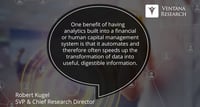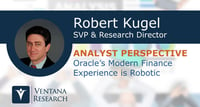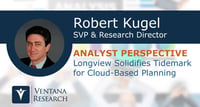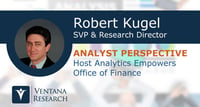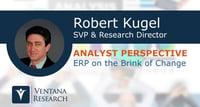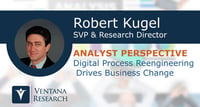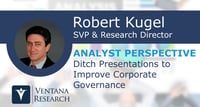Blockchains are attractive because their built-in security and trust factors make them useful for almost all business interactions involving organizations and individuals. Blockchains have two basic functions. One is as a method for handling transactions involving property such as land deeds, trademarks or other assets. The second involves exchanges of data such as identities of individuals or businesses, the location of an object at a point in time or weather conditions. All interactions...
Read More
Topics:
Big Data,
Data Science,
Mobile,
Marketing Performance Management,
Office of Finance,
Analytics,
Business Intelligence,
Cloud Computing,
Data Governance,
Data Integration,
Data Preparation,
Internet of Things,
Digital Technology,
Digital Marketing,
Digital Commerce,
Operations & Supply Chain
Workday recently presented a technology summit for industry analysts. The presentations focused on Workday’s ongoing product advancements as well as its approach to employing emerging technologies. These technologies include artificial intelligence (AI) and machine learning (ML), robotic process automation (RPA) and bots utilizing natural language processing. Ventana Research uses the term “robotic finance” to refer to these technologies when used in the office of finance. In our view, they...
Read More
Topics:
Big Data,
Data Science,
Mobile,
Machine Learning,
Office of Finance,
Continuous Planning,
Cloud Computing,
Collaboration,
Financial Performance Management,
ERP and Continuous Accounting
After more than a decade of steady development, ERP systems today are changing fundamentally, facilitated by the availability of advances such as cloud computing, advanced database architecture, collaboration, improved user-interface design, mobility, analytics and planning. This was evident when Oracle recently held its third analysts-only ERP Cloud Summit in New York to coincide with its Modern Finance Experience event. Oracle now has an increasingly robust set of business applications that...
Read More
Topics:
Mobile,
ERP,
Machine Learning,
Cloud Computing,
Robotic Process Automation,
Artificial intelligence,
blockchain,
AI
Longview recently completed the acquisition of Tidemark Systems, a planning software vendor. Longview Plan powered by Tidemark is a suite of cloud-based applications that enable corporations to plan, assess performance and communicate results more effectively. The software facilitates what Ventana Research calls “continuous planning.” This is a highly collaborative, action-oriented approach to planning that relies on frequent, short cycles to rapidly create and update integrated company-wide...
Read More
Topics:
Mobile,
Office of Finance,
Recurring Revenue,
Continuous Planning,
Analytics,
Business Intelligence,
Financial Performance Management,
Price and Revenue Management,
ERP and Continuous Accounting,
Sales Planning and Analytics,
revenue recognition
Ventana Research defines financial performance management (FPM) as the process of addressing the often overlapping people, process, information and technology issues that affect how well finance departments operate and support the activities of the rest of their organization. FPM deals with the full cycle of finance department activities, which include planning and budgeting, analysis, assessment and review, closing and consolidation, internal financial reporting and external financial...
Read More
Topics:
Mobile,
Human Capital Management,
Office of Finance,
Recurring Revenue,
Continuous Planning,
Analytics,
Business Intelligence,
Financial Performance Management,
Price and Revenue Management,
ERP and Continuous Accounting,
Sales Planning and Analytics
Oracle recently held its second ERP Cloud Summit with industry analysts. The all-day event wasn’t just about ERP. The company covered a range of its business applications, including financial performance management as well as its Adaptive Intelligent Applications. And it wasn’t just about the cloud. After more than a decade of steady developments, ERP systems have begun to change fundamentally, facilitated by the growing availability of new technologies including cloud computing, advanced...
Read More
Topics:
Big Data,
Data Science,
Mobile,
Customer Experience,
Human Capital Management,
Machine Learning,
Office of Finance,
Analytics,
Data Integration,
Internet of Things,
Cognitive Computing,
HRMS,
Financial Performance Management,
Mobile Marketing Digital Commerce,
Digital Marketing,
Digital Commerce,
Operations & Supply Chain,
Enterprise Resource Planning,
ERP and Continuous Accounting
Ventana Research recently announced the results of its latest Benchmark Research, Next-Generation ERP. The enterprise resource planning (ERP) system is at the core of nearly every company’s record-keeping and management of business processes. Its smooth and uninterrupted functioning is essential to an organization’s accounting and finance functions. In manufacturing and distribution, ERP manages inventory and logistics. Some companies use it to handle human resources functions like tracking...
Read More
Topics:
Big Data,
Mobile,
Human Capital Management,
Office of Finance,
Cloud Computing,
Collaboration,
Inventory Optimization,
Work and Resource Management,
Enterprise Resource Planning,
ERP and Continuous Accounting
Business process reengineering was a consulting fashion in the early 1990s that spurred many companies to purchase their first ERP systems. BPR proposes a fundamental redesign of core business processes to achieve substantial improvements in market and customer responsiveness, productivity, cycle times and quality. ERP systems support business process reengineering by guiding the step-by-step execution of the redesigned process to ensure that it is performed consistently. They also automate the...
Read More
Topics:
Big Data,
Data Science,
Mobile,
Customer Analytics,
Customer Experience,
Machine Learning,
Office of Finance,
Wearable Computing,
Continuous Planning,
business intelligence,
Analytics,
Cloud Computing,
Data Integration,
Internet of Things,
Financial Performance Management,
Digital Technology,
Digital Marketing,
Digital Commerce,
Operations & Supply Chain,
Enterprise Resource Planning,
Machine Learning and Cognitive Computing,
ERP and Continuous Accounting,
Sales Planning and Analytics
Senior finance executives and finance organizations that want to improve their performance must recognize the value of technology as a key tool for doing high-quality work. Consider how poorly your organization would perform if it had to operate using 25-year-old software and hardware. Having the latest technology isn’t always necessary, but it’s important for executives to understand that technology shapes a finance organization’s ability to improve its overall effectiveness.
Read More
Topics:
Big Data,
Data Science,
Mobile,
Human Capital Management,
Mobile Technology,
Office of Finance,
Continuous Planning,
Analytics,
Business Intelligence,
Cloud Computing,
Collaboration,
Financial Performance Management,
Price and Revenue Management,
Inventory Optimization,
Operations & Supply Chain,
Enterprise Resource Planning,
Sales and Operations Planning,
Machine Learning and Cognitive Computing,
ERP and Continuous Accounting
The topic of corporate governance received renewed attention recently after the publication of an open letter signed by 13 prominent business leaders, including Warren Buffett of Berkshire Hathaway and Jamie Dimon of JPMorgan Chase. The first principle the group advocated in the letter is the need for a truly independent board of directors. To achieve that aim, the letter suggests having the board meet regularly without the CEO and that the members of the board should have “active and direct...
Read More
Topics:
Mobile,
Governance,
Human Capital Management,
Office of Finance,
Consolidation,
Reconciliation,
CFO,
CEO,
board of directors,
accounting close


